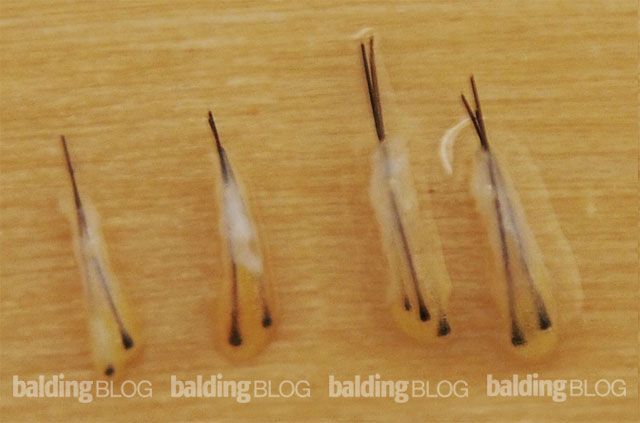FUE vs Strip — A Technical Analysis (Continued)
A couple weeks ago, we wrote a post titled: FUE vs Strip — A Technical Analysis. In it, we discussed how the anatomy of SOME follicular units in SOME patients get disrupted, stripping off the fat from the lower part of the hair follicles.
We had two patients this week that provided some good examples we can delve into —
1. Patient #1 had a strip surgery, and we harvested two 2-hair grafts and two 3-hair grafts for this example. Note that all of the anatomy is present (sebaceous gland, fat to the bottom of the hair follicles) as shown in the photo below (click to enlarge):

2. Patient #2 had FUE performed, and if you look carefully, the bottom of the grafts have some missing tissue on them. This resulted when these grafts were pulled from the scalp after the FUE was cored. Parts of the end of the graft (surrounding the bulb) are devoid of the capsule and fatty covering that can be seen in the strip grafts. The photo below shows 7 follicular units extracted by FUE in a FOX negative patient (click to enlarge):

|
From the left, grafts #1-3 had loss of fat with intact follicular sheath (glistening membrane surrounding the hair follicles). These grafts should grow well; however, no studies on such grafts have ever been done.
Grafts #4 and #6 showed that some hairs were pulled apart within the follicular unit, probably when it came out of the scalp (a common occurrence in FOX negative patients). The missing parts of the lower half of these follicles were probably not transected with the punch instrument and will not produce hair; however the remaining follicles should grow. Again though, no studies on such grafts have ever been done. Grafts #5 and #7 show intact follicular sheaths; however there is some mechanical “fracture” at the end of the intact hair shafts. We do not know if this will impact graft growth, but these changes are not uncommon in the FOX negative patients. These grafts should grow well, but… well, no studies on such grafts have ever been done. |
There’s also Patient #3 that we performed surgery on some time back with FUE2. Notice that the fat remains around the follicular units:

Patient #1 (strip) and Patient #3 (FUE2) are essentially the same quality of preserved anatomy, though Patient #2 (FUE) seems less than ideal. The question here is whether Patient #2 will grow every follicular unit with a normal hair shaft thickness. Clearly, the grafts that have missing hairs will not grow those missing hairs. The grafts that have fully intact hairs will probably grow these hairs; however, there is no certainty here and it is possible that the quality of the grafts that lost their fat from the lower half, if they grow, may grow a shaft that is less thick.
Everything about Patient #2 and the success of these grafts are unknown. In Patients #1 and #3, virtually every graft should grow to their normal potential.
I hope that these photos help you understand the fine nuances that differentiate the various forms of FUE and strip procedures, and the difference in patients as seen when comparing Patients #1 and 3 to Patient #2.
We need to have comparable grafts studied from the ARTAS Robotic System to compare apples to apples. I suspect that the ARTAS system will produce grafts that are less than perfect in the FOX negative patients.

Reader Comments0
Share this entry
Leave a Comment
Want to join the discussion? Feel free to contribute! Note: We do not tolerate offensive language or personal attacks to other readers. Marketing links or commercial advertisements will be deleted.